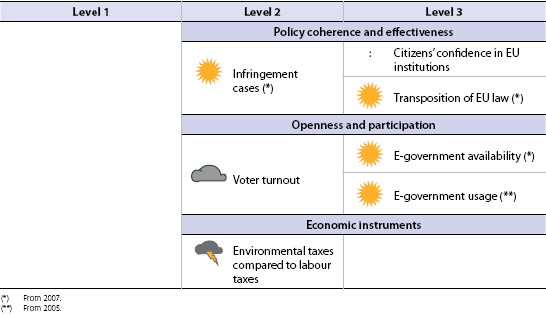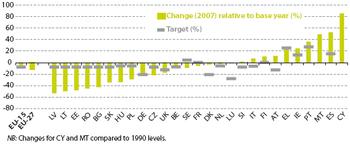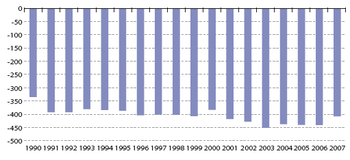Archive:Sustainable development - good governance
- Data from July 2009, most recent data: Further Eurostat information, Database.
This article provides an overview of statistical data on sustainable development in the areas of good governance. They are based on the set of sustainable development indicators the European Union agreed upon for monitoring its Sustainable development - Good Governance Sustainable development strategy. Together with similar indicators for other areas, they make up the report 'Sustainable development in the European Union - 2009 monitoring report of the EU sustainable development strategy', which Eurostat draws up every two years to provide an objective statistical picture of progress towards the goals and objectives set by the EU sustainable development strategy and which underpins the European Commission’s report on its implementation. More detailed information on good governance indicators, such as indicator relevance, definitions, methodological notes, background and potential linkages, can be found on page 259-277 of abovementioned publication.
The table below summarizes the state of affairs of in the area of good governance. Quantitative rules applied consistently across indicators, and visualized through weather symbols, provide a relative assessment of whether Europe is moving in the right direction, and at a sufficient pace, given the objectives and targets defined in the strategy.
Overview of main changes
The trends observed in the good governance theme since 2000 have been mixed. While there have been positive trends in e-government availability and usage as well as in the transposition of Community law, there have been negative trends in the number of new infringement cases brought before the European Court of Justice. Voter turnout in national parliamentary elections has fallen and is still lower for the EU Parliament. Moreover, the ratio of environmental to labour taxes has decreased and thus, a general shift towards a higher share of environmental taxes in total tax revenues has not been achieved.
Main statistical findings
Headline indicators
Citizens' confidence in EU institutions


Between 2000 and 2007 EU-15 greenhouse gas emissions have remained above the target path. However, since 2004 emissions have reduced appreciably and are moving towards the target
Although EU greenhouse gas emissions grew over the period from 2000 to 2004, the trend over the last three years has been favourable
Between 1990 and 2007, the EU-15 reduced greenhouse gas emission by 5.0 %; leaving it 3 percentage points from its reduction target for 2008-12. Although emissions rose during the first few years of the century, they have been decreasing since 2004. Overall, between 2000 and 2007, emissions decreased, but at a somewhat slower rate than over the previous decade.
According to the projections compiled by the European Environment Agency the Kyoto target should be reached with existing policies and measures, including the use of carbon sinks. With additional policies and measures and use of the so-called ‘Kyoto mechanisms’ the EU-15 is projected to overachieve its target.
In addition to the Kyoto Protocol commitment for EU-15, the EU as a whole is committed to achieving at least a 20 % reduction of its greenhouse gas emissions by 2020 compared to 1990 levels. In EU-27 emissions were 12.5 % lower than their base year level, but the major part of these reductions were made prior to 2000. Emissions in 2007 remained at virtually the same level as in 2000. According to the projections compiled by the European Environment Agency, the EU-27 is not likely to reach the 20 % reduction target by 2020. However, most Member States have not yet had sufficient time to take the effects of the EU Climate Change and Energy Package into account for preparing their projections.
The country breakdown shows a mixed picture towards targets
Overall, these figures reflect two distinct trends within the EU. On the one hand there was a modest reduction of greenhouse gas emissions in the EU-15, dominated by significant reductions in Germany (restructuring and fuel switching following unification) and the UK (fuel switching in electricity generation) which were off set by increases of greenhouse gas emissions in other Member States and in some source sectors, such as transport. On the other hand, greenhouse gas emissions in the Member States who joined the EU in 2004 and 2007, with the exception of Cyprus and Malta, decreased considerably between 1990 and 2007. Some of these Member States increased their emissions considerably between 2000 and 2007 but will nonetheless over-achieve their targets under the Kyoto Protocol. Others have been able to stabilize their emissions at their previous low levels.
Consumption of renewables
From 2000 to 2007, the share of renewable sources in energy consumption in the EU-27 did not grow in line with the target path
Consumption of renewables has grown over the last decade but the share remains far from the target
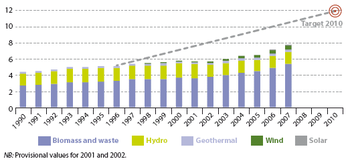

During the 1990s the consumption of renewable energies in the EU-27 increased significantly and has continued to grow between 2000 and 2007. Th is resulted in a share of 7.8 % in 2007 which remains, however, substantially below the 12 % target for 2010. Even if the highest annual change of 8.3 % between 2006 and 2007 continued, the share of renewables would remain below the target.
Biomass is by far the most important renewable energy source, delivering almost 70 % of the total renewable energy in 2007 and having the fastest growing share. Hydropower is second in importance even though both its share and its absolute contribution have diminished between 2000 and 2007 due to a series of several very dry years. Wind and geothermal energy are still minor contributors and, although their absolute growth rates are increasing rapidly, their shares are only growing slowly.
The proportion of renewables in gross inland energy consumption in 2007 varied widely between Member States. It ranged from 2.1 % in the UK to 29.7 % in Latvia and 30.9 % in Sweden, reflecting differences in resource base, mainly in respect to hydropower capacity and availability of biomass.
Biomass is the predominant renewable source, across all Member States, representing 5.4 % of EU-27 consumption in 2007. It provides 24.6 % of the gross inland energy consumption in Latvia, 19.3 % in Finland and 19.4 % in Sweden. Most of this is wood. In six Member States more than 90 % of renewable energy is derived from biomass. It is also the fastest growing share amongst renewable sources, due to the fact that biomass can be used in all three end-use sectors: power generation, transport and heating.
Second in overall importance is hydropower, which, however, not only decreased its share from 1.8 % to 1.5 % over the period 2000 to 2007 due to several very dry years, but also decreased in absolute terms. Wind and geothermal energy, whose shares have been growing at a very modest pace, are still relatively minor sources, together representing only 0.8 % of EU-27 energy consumption in 2007. In absolute terms, however, wind power capacity has been growing rapidly. It is now a significant renewable energy source in Spain, Denmark and Germany, where it makes up 22 %, 17 % and 12 % of renewables, respectively. Geothermal, generally another minor source, is the most important renewable energy source in Italy, where it represented 39 % of renewable energy in 2007. Solar energy remains the least important of all renewable energies in terms of its contribution. It represents 0.1 % of EU-27 gross inland energy consumption and 1.2 % of renewables, but its growth in absolute terms is impressive and solar energy constitutes an important renewable energy source in Cyprus and, to a lesser extent, in Greece with shares of 83 % and 10 % of total renewable energy.
Measures aimed at reducing the growth in gross inland energy consumption, for example through energy savings and improving energy efficiency, will also influence the growth rate of this indicator.
Climate change
Greenhouse gas emissions by sector
Greenhouse gas emissions decreased in most source categories between 2000 and 2007, but energy industries and transport, the two biggest emitting categories, increased their emissions, thereby offsetting some of the reductions achieved elsewhere
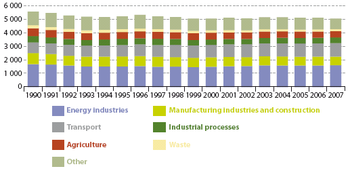
Greenhouse gas emissions from energy industries and transport offset much of the emissions decreases achieved by other sectors
Energy-related emissions represented approximately 80 % – by far the largest share – of total emissions in 2007. The largest emitting source category was the energy industries, which accounted for about 40 % of energy-related emissions, followed by transport, accounting for a further 24 % of energy-related emissions.
Between 2000 and 2007, greenhouse gas emissions produced by energy industries increased by 7.5 % in the EU-27 while energy consumption increased by 8.3 % over the same period. Greenhouse gas emissions from transport, which represented about one-fifth of all EU-27 greenhouse gas emissions in 2007, increased by 7 % in the same period. These two source categories have offset some of the emission decreases achieved elsewhere.
EU-27 emissions from industrial processes have been growing, but remained about 13 % below the 1990 level in 2006
Greenhouse gas emissions from industrial processes (CO2, nitrous oxide and fluorinated gases) in the EU-27 grew slightly between 2000 and 2007, although the 2007 level was still 9.9 % below that of 1990. Emissions from non-energy-related industrial processes are mainly CO2 from cement production, iron and steel production, nitrous oxide from nitric acid production, and hydrofluorocarbons from refrigeration and air conditioning equipment.
Other sectors saw decreases. Agricultural emissions fell by 5.7 %. Emissions in the manufacturing industry and construction dropped by 3.5 %.
Emissions from international bunkers account for a relatively small but rapidly growing proportion of greenhouse gas emissions. EU-27 GHG emissions from international aviation and maritime transport have increased by 109.7 % and 60.2 %, respectively, between 1990 and 2007.
Patterns of land use, land-use change and practices in the forestry sector can offset emissions, either by removing greenhouse gases from the atmosphere (e.g. by planting trees or improving forest management) or by reducing emissions (e.g. by curbing deforestation). On average 425 million tonnes of CO2 were removed annually between 2000 and 2007 in the EU-27, which is rather higher than was achieved over the previous decade.
Greenhouse gas intensity of energy consumption
Between 2000 and 2007 moderate progress was made in reducing the greenhouse gas emissions per unit of energy consumption
The greenhouse gas intensity of energy consumption fell at a slower rate than during the 1990s

In the EU-27, the greenhouse gas intensity of energy consumption decreased by an average annual rate of about 0.6 % between 2000 and 2007, mainly due to the switching from solid fuels to gas and, to a lesser extent, to nuclear energy and renewable energies (see also indicator ‘Gross inland energy consumption’). However, the decrease was not as strong as in the 1990s when the emission intensity of energy consumption decreased by an annual average of 1.1 %.
Global surface average temperature
The global average temperature in 2008 was 0.7 °C higher than a century and a half ago
The global surface average temperature increased by 0.7 °C over the last century
The year 2008 was among the ten warmest on record since systematic instrumental measurements began in around 1850, although slightly cooler than previous years of this century.
According to the World Meteorological Organization statement on the status of the global climate in 2008, ‘since the beginning of the twentieth century, the global average surface temperature has risen by 0.74 °C, although this increase has not been continuous. The linear warming trend over the past 50 years (0.13 °C per decade) is nearly twice that for the past 100 years’. Nevertheless, there are indications that over the past decade the global temperature rise has slowed down [1].
The Intergovernmental Panel of Climate Change (IPCC) consider that ‘there is high agreement and much evidence that with current climate change mitigation policies and related sustainable development practices, global GHG emissions will continue to grow over the next few decades’. According to all of its scenarios, the IPCC projects that the rise in temperature over the 21st century will very likely be larger than the rise over the 20th century [2].
Energy
Energy dependency
EU-27 energy dependency has risen steeply since 2000 and the level of around 55 % in 2008 is significantly higher than during the 1990s
More than half of EU energy is imported

Energy dependency shows the extent to which an economy relies upon imports in order to meet its energy needs. Despite annual fluctuations, EU-27 dependency on imported energy remained rather constant throughout the 1990s, at a level of around 45 %. Since 2000, however, the level of dependency has grown, exceeding 50 % in 2004 and reaching a level of about 55 % (based on provisional data) in 2008. This represents a degree of dependence 10 percentage points higher than the average of the previous decade.
Apart from the growing demand for energy, the larger share of natural gas which is imported from outside the European Union and declining oil reserves in the North Sea have contributed to this development.
Gross inland energy consumption
The EU’s energy demand has grown moderately. Between 2000 and 2007 EU-27 energy consumption grew faster than in the previous decade, although since 2003 it has levelled off . There has been a general shift away from solid fuels towards natural gas and to some extent renewable energies
Energy consumption has grown since 2000 but has shown signs of stabilising over recent years. An overall shift away from solid fuels towards natural gas and renewable energies has taken place
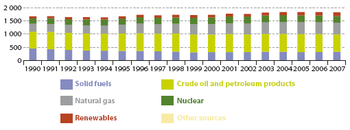
Gross inland energy consumption presented an average annual growth of 0.7 % between 2000 and 2007, slightly higher than the rate of 0.4 % in the previous decade. However, since 2003 energy consumption has levelled off . Overall, there has been a shift away from solid fuels, which represented about 27 % of the total consumption in 1990 and only about 18 % in 2007. This shift has been predominantly in favour of natural gas, rising from 18 % to 24 % over the same period, and, to a lesser extent, nuclear energy (rising from 12 % to 13 %) and renewable energies (rising from 4 % to 8 %). The share of crude oil and petroleum products decreased slightly from 38 % in 1990 to 36 % in 2007.
The rise in energy demand of about 80 million tonnes of oil equivalent between 2000 and 2007 mainly involved an increase of about 40 million tonnes of oil equivalent of both natural gas and renewable energies. While solid fuels also increased by about 10 million tonnes of oil equivalent, this was compensated by a decrease in crude oil and petroleum products, and nuclear energy.
Electricity generation from renewables
The share of renewables in electricity production increased from 13.8 % in 2000 to 15.6 % in 2007 in the EU-27, but remains below the path to the 2010 target of 21 %
Capacity of renewable electricity generation needs to speed up to meet 2010 target

Between 2000 and 2007, the contribution of electricity from biomass, hydro, wind, geothermal and solar energy increased progressively, reaching 15.6 % in 2007. After a decline during the early years of the decade, the annual growth rate is now substantially higher than during the 1990s. Between 2006 and 2007 the share of renewables grew by 1.0 percentage point. However, reaching the 21 % share by 2010 would require almost double of this rate.
Relatively long lead times for power generation investments may partially explain the previous slow progress. Prices for renewable energies, which for some technologies remain higher than conventional power generation, may also contribute to limit the speed of growth. In addition, regulatory barriers, such as difficulties in obtaining planning permission or grid access, persist in many Member States (see Commission communication Renewable energy road map. Renewable energies in the 21st century: Building a more sustainable future, COM(2006) 848).
Consumption of biofuels in transport
Biofuels are a small but rapidly growing energy source for transport. Their consumption has shown accelerated growth since 2000 and reached a share of 2.6 % in 2007 in EU-27. However, despite this growth their share remains below the target path
If growth in biofuels continues, the targets will probably be met

Between 1990 and 2000 the EU-27 share of biofuels in the petrol and diesel consumption of transport increased from zero to 0.24 %. From 2000 to 2007 the growth rate has increased leading to a share of 2.6 % in 2007.
Even though in 2007 the share of biofuels remains well below the target path, the current rate of growth would be sufficient to reach the 5.75 % target by 2010 as well as the binding 10 % target by 2020.
Combined heat and power
The uptake of combined heat and power, or cogeneration, has increased between 2004 and 2007, reaching 10.9 % of gross electricity generation in the EU-27
Combined heat and power generation has increased moderately since 2004

Despite the small decrease in 2006, the share of combined heat and power in total EU-27 electricity generation rose by 0.4 percentage points between 2004 and 2007 to 10.9 %. Although a longer time series for EU-15 is also shown in Graph 17, these data should be treated with caution due to changes in the calculation methodology over time.
According to the Energy Efficiency Action Plan, several barriers prevent expansion of capacity. These include the lack of district heating networks in many areas.
Implicit tax rate on energy
The implicit tax rate on energy fell by about 4 % between 2000 and 2007. Although this decrease in the effective tax burden on energy is inconsistent with the EU objective to shift taxation from labour onto resource and energy use, there are also indications that taxation may have stimulated energy saving
The implicit tax rate on energy has fallen since 2000

The ratio of energy tax revenues to final energy consumption represents the effective tax burden on energy. The decreases in the implicit tax rate show a decline in the effective tax burden on energy relative to the potentially taxable base. Th is is not consistent with the Sustainable Development Strategy’s principle of shifting taxation from labour onto resource and energy consumption. Nevertheless, there is some evidence that the previously high energy taxation has stimulated improvements in energy efficiency and has therefore helped to conserve energy. There has also been a greater reliance on policy instruments other than taxes, such as emissions trading. It is also true that energy taxes were reduced to compensate for the substantial rise in the oil price over recent years (see Taxation trends in the European Union, pp. 123-4).
Further Eurostat information
Publications
- Sustainable development in the European Union - 2009 monitoring report of the EU sustainable development strategy
- Energy, transport and environment indicators - Pocketbook, 2009
- Panorama of energy: Energy statistics to support EU policies and solutions - Statistical book, 2009
Database
- Indicators
- Climate Change and Energy
Dedicated section
Other information
- Commission communication, Promotion of the use of energy from renewable sources (Renewable Energy Directive), COM(2009) 28
- Commission communication, 20 20 by 2020: Europe’s climate change opportunity, COM(2008) 30
- Commission communication, An energy policy for Europe, COM(2007) 1
- Commission communication Energy efficiency: delivering the 20 % target, COM(2008) 772
- Commission Staff Working Document, The renewable energy progress report, SEC(2009) 503
- Green Paper - A European Strategy for Sustainable, Competitive and Secure Energy, European Commission, COM/2006/0105 final
- White paper - Adapting to climate change : towards a European framework for action, European Commission, COM/2009/0147 final
- Energy and environment report 2008, European Environment Agency, Report No 6/2008
- Greenhouse gas emission trends and projections in Europe 2008: Tracking progress towards Kyoto targets, European Environment Agency, Report No 5/2008
- International Energy Agency, World energy outlook 2009, IEA, Paris, 2009, in press
- Pachauri, R.K and Reisinger, A. (eds.), Climate Change 2007: Synthesis Report. Contribution of Working Groups I, II and III to the Fourth Assessment Report of the Intergovernmental Panel on Climate Change, IPCC, Geneva, 2007
- Rummukainen, M. and Källén, E., New climate science 2006-2009. A brief review of research into the physical science basis of the climate change issue since IPCC AR4/WG I of 2007, The Commission on Sustainable Development, Stockholm, 2009
- Stern, N.H., The economics of climate change: the Stern review, Cambridge University Press, Cambridge, 2007*Directive 2009/28/EC of 23 April 2009on the promotion of the use of energy from renewable sources(Renewable Energy Directive)
External links
See also
Notes
- ↑ European Council, Review of the EU Sustainable Development Strategy (EU SDS) - Renewed Strategy, op. cit., p. 3): ‘... promote sustainable consumption and production to break the link between economic growth and environmental degradation’.
- ↑ Pachauri, R.K and Reisinger, A. (eds.), Climate Change 2007: Synthesis Report. Contribution of Working Groups I, II and III to the Fourth Assessment Report of the Intergovernmental Panel on Climate Change, IPCC, Geneva, 2007, pp.44-5.
